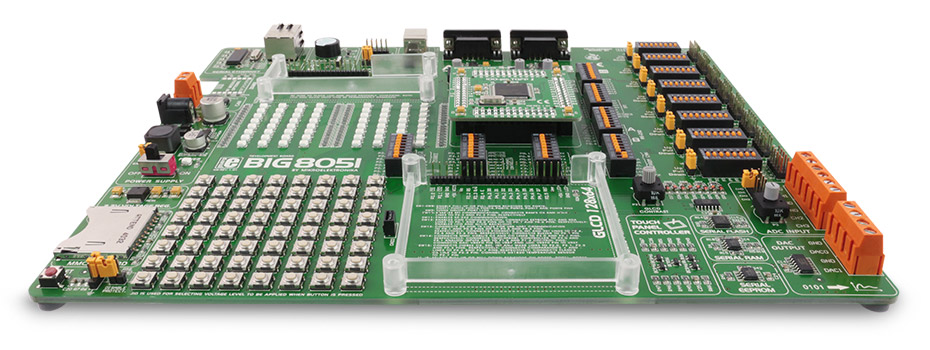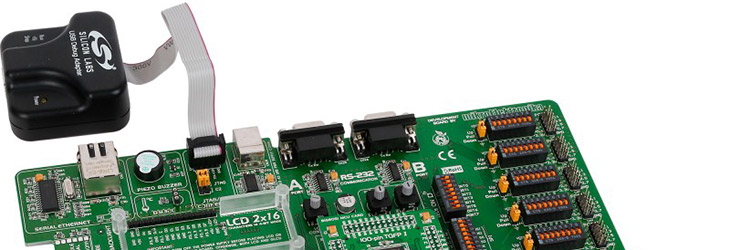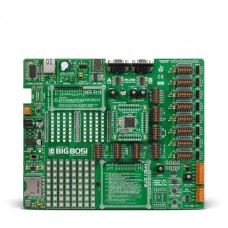BIG8051
BIG8051
This board is a full-featured development environment for Silicon Labs C8051Fxxx microcontrollers. It has numerous on-board modules that help you to create your prototype device easily. It comes with C8051f040 microcontroller.

USB Debug Adapter
Programming. System comes with fast USB Debug Adapter - programmer from Silicon Laboratories.The USB Debug Adapter provides the interface between the PC’s USB port and the C8051Fxxx’s in-system debug/programming circuitry.

Features
Storage
Storage. MMC/SD Card slot allows you to store large ammounts of data externally on MMC/SD card using fast SPI communication. Store up to 8 Mbit of data in M25P80 Serial Flash Memory with 25 MHz SPI Bus Interface. It suports over 100,000 Erase/Program Cycles per Sector and has over 20 Year Data Retention. You can store 8x256 bytes of configuration data or other data into on-board 24AA01 Serial EEPROM with I2C interface. On-board Serial RAM memory based on 23K640 offers you the power to store your variables and temporary calculation results, and therefore free on-chip RAM for other purposes.
Displays
Displays and Touch screen. Graphic LCD 128x64 and LCD 2x16 can be easily connected via the on-board connectors. Board also features a Touch Screen controller.
Ports
PORTs, buttons and LEDs. 64 Buttons have stable operation and exceptional response curve. Ergonomy is at highest level so you will feel a great difference compared to other widely used standard switches. Monitor your program execution, or create all sorts of visual signalization using on-board 64 LEDs. SMD LEDs emmit high power red light.
Interfaces
Communication and Interfaces. RS-232 communication is enabled via two DB9 connectors and MAX232 level converters. USB connector, CAN transceiver MCP2551 and a serial Ethernet module are provided on-board as well.
Power
Powering the board using USB-UART connector. USB-UART connector can be used to provide the power to the board. You should be able to run all on-board modules, including GLCD display and Ethernet. You should know that you can draw maximum of 500mA from the PC USB port.
Input
DAC, ADC, Comparators. Convert digital signals to analog voltage levels using 12-bit MCP4921 DAC chip with SPI interface. It has two separate DAC channels and is connected to output Screw Terminal. You can attach four analog inputs using hi-quality ADC Input Screw Terminal Connectors. They are connected to CH0 – CH3 analog channels of the microcontroller. You can use on-chip comparator module with all it’s features and advantages, and test your program using comparator potentiometers connected to CP0+ and CP0- pins.
Package Contains
- Damage resistant protective box
- BIG8051 development system in antistatic bag
- USB Debug Adapter with USB cable
- User Manual and Board Schematic
Specification
| Applications | Developing and testing firmware, creating prototypes, learning embedded programming |
| Displays | Connectors for GLCD 128x64 and LCD 2x16 |
| Graphic controller | Embedded inside MCU |
| Touch Screen | Resistive |
| Architecture | 8051 (8-bit) |
| MCU | Comes with C8051F040 (on MCU card) |
| On-board modules | Socket for DS1820 temperature sensor, 64 LEDs and 64 buttons, ADC input, DAC output, RF module soldering pads, |
| Programming | USB Debug Adapter - programmer from Silicon Labs (delivered in the package). IDC10 JTAG/C2 male connector should be used for programming the microcontroller using external programmer/debugger |
| Storage | Serial RAM (64 KB), Serial Flash (8 Mbit), Serial EEPROM, MMC/SD card slot |
| Sound and Audio | Piezo buzzer |
| Expandability | 1 x IDC10 header for each PORT |
| Integration | Mounting holes |
| Input Voltage | 5V (via USB) or 9-32V AC, 7-23V DC (via adapter) |
Downloads
BIG8051 - mikroC PRO for 8051 Examples
BIG8051 - mikroBasic PRO for 8051 Examples
Enter the code in the box below:












